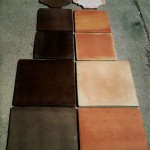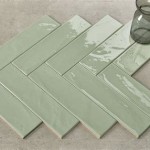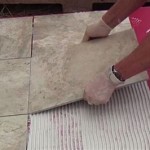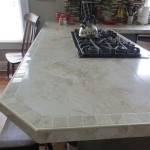Can You Lay Vinyl Flooring Over Ceramic Tile? Exploring the Possibilities and Pitfalls
The question of whether vinyl flooring can be installed over existing ceramic tile is a common one for homeowners considering a floor renovation. Instead of the disruptive and potentially costly process of removing the old tile, many seek a simpler, more direct alternative. Laying vinyl directly on top of ceramic tile can seem like an attractive option, offering a fresh aesthetic without the demolition debris and associated labor expenses. However, the viability of this approach depends heavily on several factors related to the condition of the existing tile, the type of vinyl flooring chosen, and meticulous preparation techniques.
While it is indeed possible to install vinyl flooring over ceramic tile, it's not always the ideal solution. The longevity and overall success of the new flooring installation are contingent on addressing potential issues before the vinyl is laid. Failing to adequately prepare the subfloor can lead to problems such as telegraphing (where the grout lines or imperfections of the underlying tile are visible through the vinyl), unevenness, compromised structural integrity, and ultimately, the need for premature replacement of the vinyl flooring.
Key Considerations Before Installation
Before embarking on a project to lay vinyl flooring over ceramic tile, a thorough assessment of the existing conditions is crucial. Ignoring potential problem areas can lead to costly repairs and dissatisfaction with the final result. Several factors must be carefully considered to determine if this approach is suitable for the specific situation.
Condition of the Existing Ceramic Tile
The most important factor is the condition of the ceramic tile itself. It must be structurally sound, meaning there should be no loose, cracked, or broken tiles. Any deficiencies need to be addressed before proceeding. Loose tiles create voids and unstable areas that will compromise the integrity of the vinyl flooring. The movement of loose tiles will eventually cause the vinyl to crack or become uneven. Similarly, cracked or broken tiles will telegraph through the vinyl, creating visible imperfections and potentially causing tears or punctures over time. Repairing or replacing any damaged tiles is essential to create a stable and even subfloor.
Furthermore, the surface of the ceramic tile should be relatively even. Significant variations in height between tiles, or lippage, will be noticeable through the vinyl. While a self-leveling compound can be used to address minor height differences, extreme unevenness may necessitate tile removal. Evaluating the overall flatness of the tiled surface with a long level or straight edge is a critical step in the assessment process.
Type of Vinyl Flooring
The type of vinyl flooring being considered also plays a significant role in determining the feasibility of laying it over ceramic tile. Certain types of vinyl flooring are more forgiving and better suited for this application than others. Generally, thicker and more rigid vinyl options are preferable. Sheet vinyl, luxury vinyl planks (LVP), and luxury vinyl tiles (LVT) are common choices, each with its own set of pros and cons.
Thicker vinyl flooring is better at concealing minor imperfections and irregularities in the underlying tile surface. It also provides a more cushioned and comfortable feel underfoot. In contrast, thinner vinyl flooring is more likely to telegraph the grout lines and any unevenness. LVP and LVT, with their interlocking or glue-down installation methods, offer greater stability and resistance to movement compared to thinner sheet vinyl.
Furthermore, the manufacturer's recommendations should always be consulted before installing any type of vinyl flooring. Some manufacturers explicitly prohibit installation over ceramic tile, while others provide specific guidelines for surface preparation and installation techniques. Adhering to these recommendations is vital to ensure the warranty remains valid and to achieve a successful and long-lasting installation.
Subfloor Preparation
Proper subfloor preparation is paramount to the success of installing vinyl flooring over ceramic tile. Even if the existing tile is in good condition, meticulous preparation is essential to create a smooth, even, and stable surface for the new flooring. This typically involves cleaning, leveling, and potentially patching or skim-coating the tiled surface.
The first step is to thoroughly clean the ceramic tile to remove any dirt, grease, wax, or other contaminants. A degreasing cleaner and a stiff brush can be used to scrub the surface and ensure that it is free of any residues that could interfere with the adhesion of the vinyl flooring or leveling compounds. After cleaning, the surface should be rinsed thoroughly with clean water and allowed to dry completely.
Next, the grout lines need to be addressed. Grout lines are typically recessed below the surface of the ceramic tile, and these depressions can telegraph through the vinyl flooring. Filling the grout lines with a cement-based patching compound is necessary to create a smooth and even surface. The patching compound should be applied carefully and allowed to dry completely before sanding it smooth. Multiple applications may be required to completely fill the grout lines and achieve a level surface.
In cases where there are significant height variations between tiles or the overall surface is uneven, a self-leveling compound may be necessary. This liquid compound is poured over the entire tiled surface and allowed to flow and level itself. Once dry, it creates a perfectly smooth and even surface for the vinyl flooring. However, self-leveling compounds can be expensive, and their application requires careful planning and execution to ensure proper coverage and bonding.
Installation Considerations
Once the subfloor has been adequately prepared, the installation of the vinyl flooring can begin. However, there are still several important considerations to keep in mind during the installation process to ensure a successful outcome.
Adhesive Selection
Choosing the right adhesive is crucial for ensuring that the vinyl flooring bonds properly to the prepared ceramic tile surface. The adhesive must be compatible with both the vinyl flooring and the existing tile. It should also be resistant to moisture and temperature fluctuations. Consulting the vinyl flooring manufacturer's recommendations for adhesive selection is essential to ensure compatibility and optimal performance.
Different types of vinyl flooring require different types of adhesives. For example, sheet vinyl typically requires a full-spread adhesive, while LVP and LVT may be installed using a click-lock system or a perimeter-bonded adhesive. The adhesive should be applied evenly and according to the manufacturer's instructions. Using the wrong type of adhesive or applying it incorrectly can lead to bonding failures and premature degradation of the vinyl flooring.
Acclimation
Acclimating the vinyl flooring to the room's temperature and humidity is another important step in the installation process. Vinyl flooring can expand and contract with changes in temperature and humidity, so allowing it to acclimate for at least 48 hours before installation will help prevent warping or buckling after installation. The vinyl flooring should be laid out in the room where it will be installed and allowed to adjust to the ambient conditions. This process is particularly important for LVP and LVT, which are more susceptible to dimensional changes than sheet vinyl.
Seams and Transitions
Properly sealing seams and transitions is essential to prevent moisture from penetrating underneath the vinyl flooring and damaging the subfloor. Seams should be carefully aligned and sealed with a seam roller and a seam sealant. Transitions to other types of flooring should be handled with transition strips that are designed to accommodate the height difference between the vinyl flooring and the adjacent flooring. These transition strips should be securely fastened to the subfloor to prevent tripping hazards and ensure a smooth and professional finish.
Potential Drawbacks and Alternatives
While installing vinyl flooring over ceramic tile can be a viable option in certain situations, it's important to acknowledge the potential drawbacks and consider alternative solutions. Some of the potential drawbacks include:
*
Increased Floor Height:
Adding vinyl flooring on top of ceramic tile will increase the overall floor height, which may create issues with door clearances and transitions to other rooms. *Telegraphing:
Even with proper preparation, the grout lines or imperfections of the underlying tile may still be visible through the vinyl flooring over time. *Moisture Trapping:
If moisture becomes trapped between the vinyl flooring and the ceramic tile, it can lead to mold growth and damage to the subfloor. *Difficulty Removing:
If the vinyl flooring needs to be replaced in the future, removing it from the ceramic tile can be difficult and time-consuming.Given these potential drawbacks, it's worth considering alternative solutions such as:
*
Removing the Ceramic Tile:
While more labor-intensive, removing the ceramic tile provides a clean and level subfloor for the new vinyl flooring. This is often the best option for achieving a long-lasting and trouble-free installation. *Installing a Floating Subfloor:
Installing a floating subfloor over the ceramic tile can create a smooth and level surface for the vinyl flooring without the need for extensive patching or leveling. *Choosing a Different Flooring Material:
Other flooring materials, such as engineered hardwood or laminate, may be more suitable for installation over ceramic tile, depending on the specific conditions and desired aesthetic.Ultimately, the decision of whether to lay vinyl flooring over ceramic tile depends on a careful assessment of the existing conditions, the type of vinyl flooring being considered, and the homeowner's budget and expectations. Weighing the pros and cons and considering alternative solutions will help ensure a successful and satisfying floor renovation project.

Should You Install Vinyl Floor Over Tile

New Vinyl Plank Flooring Over Tile Table And Hearth

What Type Of Flooring Can You Install Over Ceramic Tile

New Vinyl Plank Flooring Over Tile Table And Hearth

New Vinyl Plank Flooring Over Tile Table And Hearth

How To Lay Vinyl Flooring Sheet Over Tiles

Can You Put Vinyl Plank Flooring Over Ceramic Tile Floors Blvd

Lvt Flooring Over Existing Tile The Easy Way Vinyl Floor Installation Diy

Can Vinyl Flooring Be Laid Over Tiles Ox

Can You Put Laminate Flooring Over Ceramic Tiles Mellowpine
Related Posts








